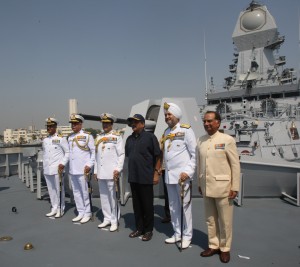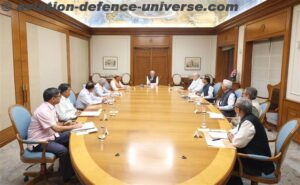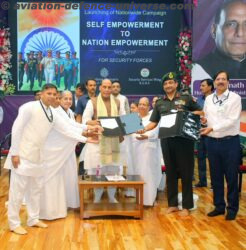- NAVY’S DIRECTORATE OF NAVAL DESIGN (DND) AND WEAPONS ELECTRONICS SYSTEMS ENGINEERING ESTABLISHMENT (WESEE)
By Cmde(Retd) Ranjit B Rai. September. When Defence Minister Manohar Parrikar recently commissioned INS Kochi, the second ship of the indigenously designed and home built Project 15A of the Kolkata-class guided missile destroyers built by Mazagon Docks Ltd (MDL), Modi’s government reaffirmed its commitment to develop a true Blue Water Navy, which can dominate the Indian Ocean Region (IOR), and considered friendly by India’s neighbouring nations.
India has the onerous role of a Net Security Provider in the IOR, and a Blue Water Navy entails the capability of self sustained expeditionary task force operations away from home shores for prolonged periods. India will need at least two task forces with aircraft carriers with aviation assets, Fleet ships, nuclear submarines and support tankers and for this 7,400 ton INS Kochi is a welcome and powerful addition. 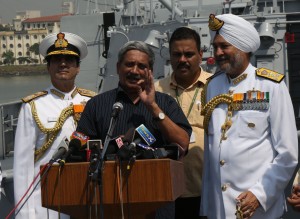 The INS Kochi has an indigenous content of 80 % of machinery, equipment, electronics and control systems and the Chief of Naval Staff Admiral RK Dhowan has proudly stated that India has achieved the capability to design and build all class of warships and submarines in India and over forty five ships including a 37,500 ton aircraft carrier Vishal at Cochin Shipyard Ltd (CSL) and two more nuclear ICBM submarines (Aridhaman) in a PPP with Larsen & Toubro Ltd (MDL) at the DRDO’s Ship Building Centre Vishkapatnam are on order in Indian shipyards. This, for a developing nation and a small 75,000 strong uniformed Navy is no mean achievement.
The INS Kochi has an indigenous content of 80 % of machinery, equipment, electronics and control systems and the Chief of Naval Staff Admiral RK Dhowan has proudly stated that India has achieved the capability to design and build all class of warships and submarines in India and over forty five ships including a 37,500 ton aircraft carrier Vishal at Cochin Shipyard Ltd (CSL) and two more nuclear ICBM submarines (Aridhaman) in a PPP with Larsen & Toubro Ltd (MDL) at the DRDO’s Ship Building Centre Vishkapatnam are on order in Indian shipyards. This, for a developing nation and a small 75,000 strong uniformed Navy is no mean achievement.
It is in this context Aviation & Defence Universe in its maiden post unveils the role played by the Directorate Of Naval Design (DND) and the Weapons Electronics Systems Engineering Establishment (WESEE) in achieving the status of a builder’s Navy.
The DND and WESEE have contributed the most critical aspects of warship building and saved much foreign exchange and ensured the Intellectual Property Rights (IPR) to execute modifications and improvements are strictly held in country, and will prove most helpful in export of warships and naval systems in the future. DND and WESEE have shared much with DRDO and industry, especially the Bharat Electronics Ltd (BEL) and ECIL to modify ships and produce equipment commercially for the Navy. Indigenous sonars, the Humsa and Nagin and Integrated Communication systems and missile fire and control figure in this list, which has helped sister services too.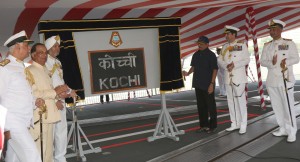
DND has provided the detailed design of the naval platforms to float, to move, to fight and survive to fight another day. The WESEE network with civilian soft ware firms, in co-ordination, have provided the electronics, modems for data transfer, cyber and communication security and the command and control systems to ensure error free ‘detection of enemy to shooter’ of systems in minimum time for powerful weapons, which are now ‘one shot kill weapons’ and INS Kochi has them. The WESEE has ensured connectivity for the Commands and Naval Headquarters via HF/VHF links and the satellite Rukmini terminals fitted on all major warships for GSAT-7 built by Indian Space Research Organisation (ISRO) with UHF, Sierra, Ku and Charlie bands for encrypted net-worked data transfers and voice talks.
The Corps of Naval Constructors ( also known as Naval Architects) was established as a specialist arm of the Engineering branch of the Indian Navy on 17th November, 1956 with three foreign trained civilian constructors led by late Padma S Paramanandan, Sam Dotiwala and VS Dhumal in the nascent Corps. The first uniformed Naval Constructor in the Indian Navy was Late Cmde Ved Prakash Garg (1929–1983). While the first Constructor officers were trained at Royal Naval College at Greenwich IN London, few naval architects were inducted from IIT Kharagpur, the only institution which qualified Naval architects.
Canada trained naval architect Sethna who had joined Mazagon Docks Ltd (MDL) and assisted in building and commissioning the first large Indian warship INS Nilgiri in 1973 which was a Leander design bought out from Yarrow Ship builders Ltd Glasgow Scotland and modified by DND for Indian conditions. Nilgiri was fitted with Navy’s first twin batteries of anti aircraft missiles, the Seacat, which performed well and a ship borne helicopter the ASW capable Alouttee. These were the pioneers of what became DND. It was the early vision of ambitious and risk taking Naval planners to strive for a ‘Builders Navy’, that led to setting up of a small ‘Central Design Office’ in 1964 which later expanded as the Directorate of Naval Design in 1970 to design warships in a Surface Ship Group (SSG) which today boasts of a large ‘state of the art’ design bureau in New Delhi’s Greater Kailash buzzing with activity. Officers of the Corps can now boast they actively contributed much in diverse fields of ship and submarine design, their construction, repair and maintenance and also R&D in Naval research institutions. These versatile officers have even played a role in the naval variants of the country’s prestigious Guided Missile Programmes at sea like the Dhanush, BrahMos, Sagarika now named K-15/B-05 which plug and play weapon system will go on the SSBN Arihant now undergoing deep sea trails off Vishakhapatnam to provide India’s second strike from the sea.
It was the early vision of ambitious and risk taking Naval planners to strive for a ‘Builders Navy’, that led to setting up of a small ‘Central Design Office’ in 1964 which later expanded as the Directorate of Naval Design in 1970 to design warships in a Surface Ship Group (SSG) which today boasts of a large ‘state of the art’ design bureau in New Delhi’s Greater Kailash buzzing with activity. Officers of the Corps can now boast they actively contributed much in diverse fields of ship and submarine design, their construction, repair and maintenance and also R&D in Naval research institutions. These versatile officers have even played a role in the naval variants of the country’s prestigious Guided Missile Programmes at sea like the Dhanush, BrahMos, Sagarika now named K-15/B-05 which plug and play weapon system will go on the SSBN Arihant now undergoing deep sea trails off Vishakhapatnam to provide India’s second strike from the sea.
Another classified design group was set up to modify and design submarines in the RK Puram defence complex, and the Corps celebrated 50 years of glorious contributions to the nation with its Golden Jubilee on 17 Nov 2006 as part of the Navy Week celebrations, when the Navy publically declared some of the classified activities of DND to industry and later invited foreign naval architects to a seminar in 2014 to chart a course for the future.
In a short span of half a century, Indian Navy and the nation with no established ship design capability is today contributing to Prime Minister Narendra Modi’s Make in India thrust, as torch bearers. The past generations of progressive naval leadership brought fruit in their vision to bring about self-reliance in designing, building and maintaining naval combatants employing “home-grown” talent. Today a strength of about 300 men and women officers man DND to cope with the increasing demand for newer indigenous warships, and about 150 shipwright sailors are trained in their specialisation at the Navy’s Shipwright school at the Naval Dockyard Visakhapatnam, and support ships serving at sea.
Most of what research work and execution the Electronics Systems Engineering Establishment (WESEE), like the DARPA of USA and such organisations do, is kept classified. The Navy for the first time at the July 2015 seminar unveiled the hitherto classified details how Weapons the Navy’s own in house research set up, and now also staffed with DRDO men and women scientists alongside naval officers and how it has supported the Navy in upgrading soft ware and electronics equipment across the fleet. WESEE has also provided operational solutions, designed naval net works, catered for cyber security with interactive modems for full range of communications including space, and inter-phased Russian and Western weapon systems on board front line ships. WESEE has designed a world class Combat Management System (CMS) on board INS Kolkata and Kochi and all ships in the last decade. . WESEE’s products which includes Link 1 to Link III for HF/VHF data digital communications, and these are manufactured and set to work by government owned Bharat Electronics Ltd (BEL), which also supplies indigenous panoramic sonars. Atlas Electronix Ltd Germany is supplying six towed sonars (ATAS) and the rest will be built in India in the Make in India programme, to which the Navy is committed.
Currently there are twenty seven major shipyards (8 public and 9 private sector) which have the capability to build vessels upto 1,10,000 Dead Weight Tonnage (DWT) , small in comparison with Japan, Korea and China but DND and WESEE are currently engaged in designing a 65,000 ton futuristic aircraft carrier which could even have nuclear propuslion in collaboratrion with USA and eight submesicble Submarine Nuclear (SSNs) sanctioned by the Defence Acquistion Council (DAC) and the task is stupendous but the Indian Navy has buckled up to meet the challenge and needs the support of the nation as torch bearers in Make in India.
The author Cmde Ranjit B Rai is a defence expert and author of a WARRING NUCLEAR NATIONS-INDIA AND PAKISTAN (ISBN 978-93-5158-638-0)






































